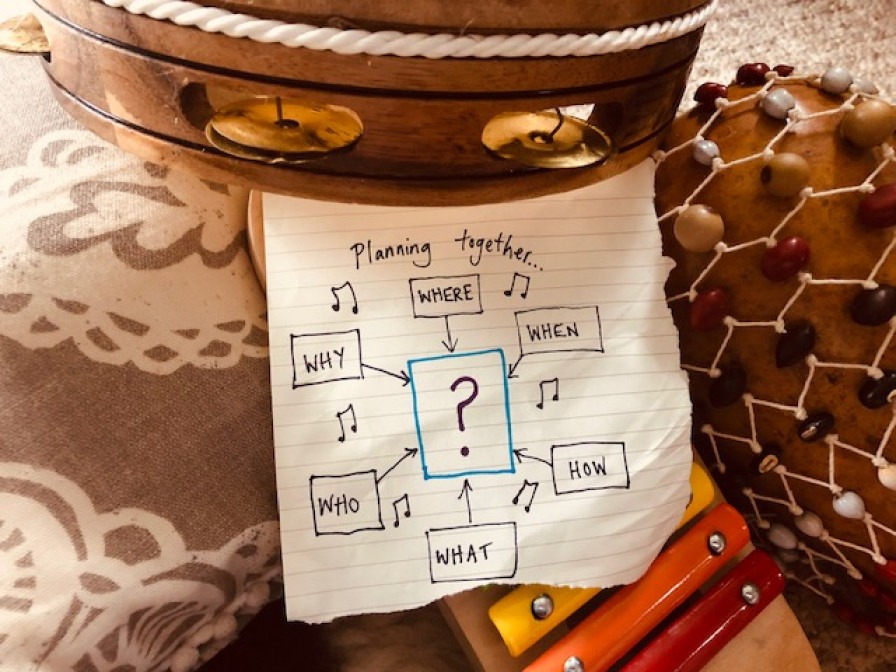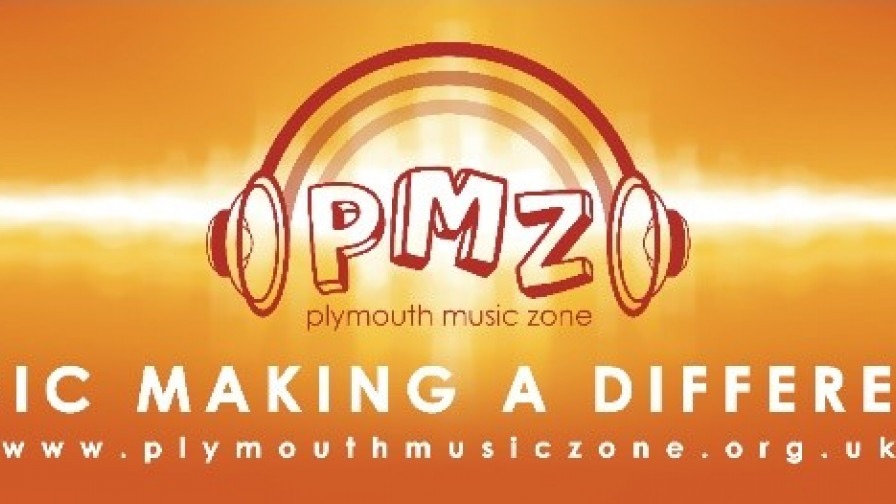Plymouth Music Zone Booster Training - sharing learning with SEN/D school staff

Part of Plymouth Music Zone’s ‘Breakthrough Music’ and Tuning into Transitions funding supported the delivery of twilight training sessions for teachers and support staff across special schools in Plymouth over the past few years. These ‘Music Booster Training’ sessions were tailored to each school and included ideas for ongoing music development for both pupils and staff, building confidence and testing out ideas outside the classroom.
This training was led by music leaders, Holly Bench and Jodie Saunders who were also delivering sessions in the schools. They shared their thinking, planning and practical ideas with school staff. In addition, they gave practical sessions on things like simple accompaniment and useful song materials.
This training helped highlight the background thinking that the music leaders were doing, which was particularly valued by staff who were able to reflect on pupils who they were able to observe differently through musical activity. It was also noted that staff appreciated the music leaders offering a different lens / perspective too on what could be possible by trying things out. They shared practice that had taken place in schools different to the ones where the training was delivered to make suggestions and find out which ones had traction.
Challenges were finding suitable time for staff to have training, as twilight training was often taken up early on each term and music was generally not prioritised. They were also often called to deal with other situations at the time of the training.
Here are the music leaders' notes on activities, plans, reflections with one another and staff and building projects around the children themselves…
Key Themes Explored:
- Routines
- Group Work
- Individual Interactions
- Using Musical Instruments
- Using Technology
- Voices and bodies
- Cross-arts and cross-curricular work
Activities covered in different schools:
- ‘Graphic Scores’
- Conducting using either hands or feet
- Conducting using coloured Boomwhackers
- Starting and Stopping games
- Songs and choosing using song cards
- Adapting songs and using props (e.g. parachute)
- Confidence-building through familiar songs
- Age appropriate games to extend familiar materials and songs
- Call and response (leading and copying) e.g. name syllables
- Solos – developing confidence
- Passing sounds around a group – turn-taking and experiencing different kinds of sounds
- Human Piano! (Sequencing notes)
- Introducing unusual sounds and instruments for sound effects in storytelling
- Promoting talk around what sound and memories / ideas
- Makaton signed songs
- Using music technology to augment and amplify voices – (linked to a theme or story) – encouraging vocalisations, including sounds of the breath when working with post-verbal children
- Synthesisers
- iPad music apps
- Using parachute games to work with emotions
- Developing confidence and musical skills
- Developing a sense of ‘group’ and belonging through music making
How we plan:
- person-centred and around the needs of the groups as a whole.
- We try to link to curriculums and themes, but at times this may not be appropriate or useful and music sessions are run separately.
- Keeping the activities clear and simple with repetition built into the sequence.
- We are often surprised how much fun the children can have and build on with simple activities – working creatively together to achieve and enjoy this.
Routine Session Plan:
- Hello Song with names – acknowledging one another from the outset
- Song cards – choosing songs using pictures
- Main activity
- Warm-down / calming activity
- Goodbye Song
Group Work:
- Ensure that inclusive practice means everyone can take part at a level that suits them, without underestimating the children’s abilities
- Listen and talk about what they have heard (active listening or showing they are engaging through movement, visual representation and/or words)
- Take turns using instruments and music technology
- Create opportunities for the children to take-the-lead / take solos or encourage their peers to do so in a supportive way.
- Build up a sense that with music there is no ‘wrong’ in order to help develop confidence.
- Ensure seating arrangements are used to change the feel of a normal classroom setup to help define music sessions (circle format helps us to promote this sense of equality and also allows us to observe the children and the group as a whole)
Individual Interactions
- Develop a sense of how to observe individuals without having much contact time in sessions
- Develop intuitive observation in terms of noticing change in behaviours / body language / confidence and where there is a sense that something has shifted
- Work in a different way to ‘tuition’ – i.e. try to get down to the same physical level and giving children the opportunity to choose to make eye contact etc.
- Interactions with instruments e.g. ‘conversations’ with music, such as ‘call and response’ – make choices about which instruments are of interest etc.
Using Musical Instruments - things we used
- Drums and hand-percussion
- Bells (including coloured bells matched to pitch)
- Tuned percussion
- Un-tuned percussion
- Unusual instruments used for sound-effects e.g. ocean drum/ thunder drum / Vibraslap / Flexatone
- Boomwhackers (with the addition of colours)
- Ukuleles (either as accompaniment or for children to try)
- Software instruments on iPads with Bluetooth speakers to amplify sound
Using Technology
- Augment and amplify voices – (including sounds of the breath when working with post-verbal children) using Korg Kaossilator and Korg Kaoss pad and microphone
- Synthesisers – children ‘writing names’ to explore the playing surface of a Kaoss pad synthesiser. In some settings we explored using different parts of the body to operate the playing surfaces e.g. elbows / noses etc.
- iPad music apps allow voice-changing and recording samples (e.g. Keezy)
Voices and bodies
- Conduct using different ways of using the body e.g. running on the spot to play fast
- Indicate dynamics (loud and quiet) through obvious and recognisable gestures
- Action songs (not being afraid to repeat for familiarity – building confidence) as well as extending and adapting the materials
- 'Beans game' – warming up bodies e.g. jumping beans / jelly beans / baked beans!
- Breathing and gentle stretching games for children with less mobility
Cross-arts and cross-curricular work
- Used bodies and movement for conducting / actions songs and responding – linked to some other curriculum areas, such as literacy
- Storytelling (Pantomimes!) with sound effects and dramatising characters
- Individual Learning targets – helping to support and evidence these e.g. listening better / making choices
- Graphic Scores linked to art – drawing whilst music was playing and mapping out where different sounds happen
Performance and Evaluation
- Allowing space to ‘show things back’ at the end
- If part of the class are the audience - good to practice sharing respectfully e.g. sharing a positive comment with someone else – promoting communication with their peers / age group
- Children able to self-evaluate through watching videos on the i-pad or through hearing themselves in recordings
- Evaluation games e.g. smiley face at one end of the room and vice versa
- Pass-the-puppet (speak or sign when you have the puppet in hand and say likes and dislikes) – film this for evidence.
The music leaders were able to offer their perspectives as non-school staff and although some things inevitably would present challenges in different places, school staff started to weave some of the music leaders’ ideas into their work and a significant benefit was that they expressed an better appreciation of the professionalism and care taken to plan music delivery in their schools. There was definitely a two-way appreciation of one another’s work and a chance to reflect on just how much learning could be achieved using music as a tool and plenty of evidence to capture too. Training complemented the sessions themselves and deepened mutual understanding and therefore improved the depth and quality of the delivery, leaving a positive legacy too!
An older post I created with feedback directly from a teacher who received some music booster training in the past and what it meant to her: https://network.youthmusic.org.uk/posts/tailored-music-training-plymouth...
Great practice-sharing:
And a great recent blog from Drake Music about inclusive practice: https://www.drakemusic.org/blog/ben/22-tips-for-inclusion-accessibility-...




